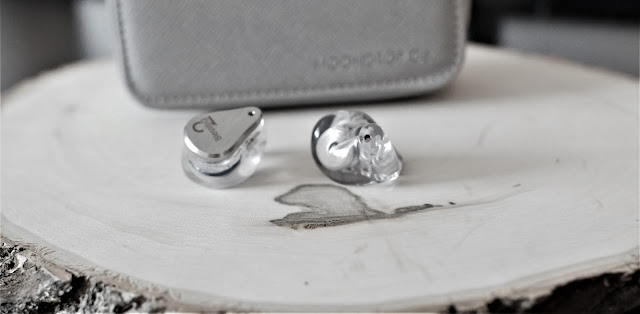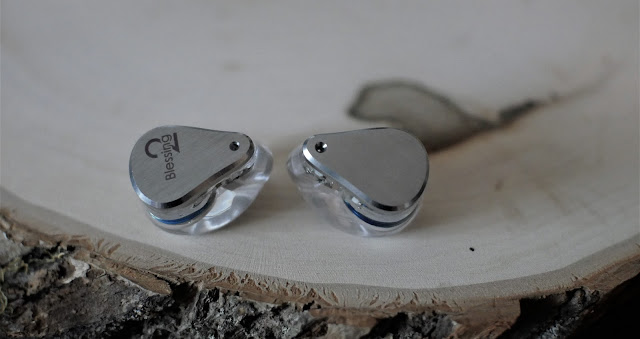The Moondrop Blessing 2 is the latest iteration of the
lowest priced hybrid IEM in Moondrop’s lineup and comes in at $319 USD, which
is an $80 price drop from the original Blessing. Unfortunately, I have never
had the chance to listen to the original Blessing, so this review won’t be able
to do any side-by-side comparisons of the two. That aside, I have listened to a
few other Moondrop offerings and I think that this is my favorite of the ones
I’ve listened to, albeit, this is also the most expensive one of the Moondrops
I’ve heard with a tie to the Chaconne. I have not heard the S8 and A8 yet.
I purchased the Blessing 2 on Hifigo.com.
https://hifigo.com/products/moondrop-blessing-2-1dd-4ba-hybrid-hifi-in-ear-earphones-iem
The Moondrop Blessing 2 is a 5-driver hybrid with a single
10mm dynamic driver and 4 balanced armature drivers to handle the mid-range and
treble. The DD handles the low end, while a custom dual-BAs carry the
mid-range, and dual-Knowles SWFK handle the upper frequencies. The original Blessing was also a 5-driver set-up;
however, I believe the drivers have been switched for the Blessing 2.
Another key change is the housing. The shell is now a little
wider and more triangular in shape. The 3D-printed housing is highly
transparent, and the faceplate on the back is now a machined stainless steel
with the “Blessing 2” logo engraved into it. There is also a small vent port on
the apex of the faceplate.
Sound
About a year ago, I decided to come up with a personal
preference curve target for in-ear monitors that I occasionally use to equalize
headphones to using Room EQ Wizard and my various equalizer tools. This personal
curve has a small bass shelf-life and a slightly reduced upper mid-range and
lower treble than the Diffuse Field and Harman Target curves. The bass boost
was right in-between the Harman IE 2017 curve and a traditional
Etymotic/Diffuse Field target bass response.
When I measured the Blessing 2, I found that it hit my
target almost exactly, or about as close as you can get realistically without
any DSP. Does this mean it’s amazing and excellent? Not necessarily, but I will
say that the tonality is really enjoyable for me, and the added dynamic driver
for the low end does give off a more natural decay and sound than a traditional
balanced armature, however with a reduction in shear detail and clarity.
To put things a bit more into perspective, musical tastes as well as preferential tastes and ear anatomy can all play a role into how my preference target was established, and everyone's will be slightly different, which is why the Harman Target is important, but is still a moving target. That aside, the majority of my musical listening nowadays revolves around indie rock, jazz, country/folk, bluegrass, post-rock and older rock and new wave music. I don't typically listen to modern pop music too often and my EDM days are behind me for the most part, however I have a fond liking for 90's and early 2000's rock music.
The Blessing 2 doesn’t have a powerful bass response and
with that, I think some people may find it lacking. It’s a slightly elevated
bass response from a flat neutral response, and well below a Harman Target
sub-bass boost. It doesn’t necessarily slam or have a great impact, but it does
have subtle hits that work well to keep it in-line with the mid-range and
reduce any carry over bloat, and it does help highlight some texturing of the
low end.
While its quality isn’t quite hitting IEMs above it’s price
point, I find it falls well in-line with other IEMs in this price point, if not
surpassing some above it. It’s a little challenging to tell at times, since the
Blessing 2’s dynamic driver is a little more muted than say the slightly
lower-priced $299 Dunu DK2001 and $469 DK3001 Pro that I recently reviewed, and
so with those two Dunu products, the bass is bigger, with more obvious
texturing that you can hear and feel. The Blessing 2 may slightly lack some of
the texturing, as it’s not as apparently bold as other dynamics with bigger
bass responses.
When comparing to both of those two hybrids, I also find the
Blessing 2 a little more boring in its presentation overall. This is because it
has the smallest amount of dip in the mid-range while the other two hybrids
having a more V-Shape. That’s going to come down to a bit of taste of course,
and I find the fun V-presentation can be quite enjoyable on the DK2001, while
the DK3001 Pro has a nice balance between the DK2001 and the Blessing 2.
The Blessing 2’s mid-range is the most complete though. It’s
easily the most linear and puts both male and female vocals in-line with one
another, with no real frequency overlapping any other. It’s generally a neutral
sound through out this range with good quality output. The mid-range BAs, from
what I understand, are custom sets borrowed from the more premium SoftEars
lineup, and is tuned and put to work rather well on the Blessing 2.
The upper mid-range and treble area is just where I like it,
with perhaps a slight sense of shoutiness, if one were to listen loudly. I
prefer this area to have a little more energy, though not on the levels of the
Harman or Diffuse Field targets, and I think this tuning strikes a nice
balance. The lower treble doesn’t have any sibilant issues with songs I
normally test with and there’s no weird harshness or any fatiguing problems or
any ringing to speak of.
I actually find the overall resolution and clarity to be
solid if not great for this price point and then some. The BA drivers do a
great job of showcasing music, specifically my current favorites, GoGo Penguin
with good technical ease. I’ve been listening to this band a great deal with
other IEMs like the Hidition Viento, Fearless Dawn, and 64 Audio U12t and qdc
Anole VX, and the Blessing 2’s really only deficiency in terms of actual detail
retrieval really comes down to the bass driver which can’t compete in the speed
and resolution of the BAs used. That said though, a dynamic driver’s natural
decay is sometimes missed and the Blessing 2 does present those instruments
with just a little more natural tonality, though I do prefer the Dunu’s dynamic
driver presentation a bit more.
The Blessing 2 doesn’t seem to have any issues with
congestion. The soundstage width is above average, while it does have a small
amount of depth with average layering capabilities. I listened to Tool’s Jambi
and instruments played where I expected them to be and without any thing
sounding too forward or congested. There was a sense of height though neither
of these were towards the extreme of what I’ve heard before but not
claustrophobic either.
Overall
Some may find this lacks bass response, and some may find it
to be a little shouty, but for me, I really enjoy this IEM since it has the
tonality I am looking for, and has enough technical ability to keep myself very
satisfied, especially given its price. The area where I am a little hesitant to
recommend is more along the size and fit of the Blessing 2. It has a very
large, yet shallow nozzle which can make uncomfortable for some, including
myself. I eventually found tips that worked for me, but I had to go through
several dozen (no joke) to find the right combination with my ear shape.
Moondrop has really gotten really good at this tuning business, with target curves they set out for and achieve quite well. Some may find that their product lineup is all too similar, but sometimes a bit of consistency isn't a bad thing either.
Moondrop has really gotten really good at this tuning business, with target curves they set out for and achieve quite well. Some may find that their product lineup is all too similar, but sometimes a bit of consistency isn't a bad thing either.
--
View the product ratings on
Antdroid's IEM Ranking List and/or Antdroid's Headphone Ranking List







This comment has been removed by the author.
ReplyDeleteHi!
ReplyDeleteWhat tips did you end up using? I've gone though the stock and default and still not getting proper isolation. All the best!
yeah · please say what tips? Really like the sound but feel them pressing all the time. Comply are probably the best but still not comfortable
ReplyDelete